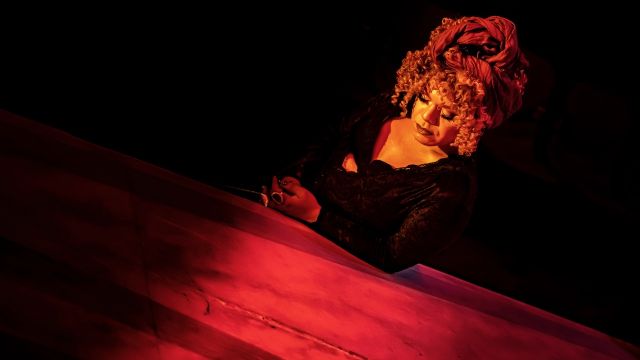And She Would Stand Like This
At the end of Pat Barker’s, The Silence of the Girls (the prequel to her version of Women of Troy), the female slave narrator, Briseis, asks, ‘What will they make of us [Trojans], the people of [the] unimaginably distant [future]? …they won’t want the brutal reality of conquest and slavery… the massacre of men and boys, the enslavement of women and girls.’
Playwright Harrison David Rivers found In Euripides’ ancient classic drama Women of Troy the metaphor, the structure, and the characters to tell a story of the onset of AIDS/HIV in 1980s New York – something too which people ‘won’t’ and don’t want.
Rivers melds Euripides’ story and characters with the style and the characters of Jennie Livingstone’s 1990 documentary Paris is Burning about the LGBTQIA+ ball culture – that is, dance culture - and the people within it. Like the movie, much depends on quiet and touching monologues about some characters’ childhoods. Here, Queen Hecuba (Kikki Temple) is the fierce, imperious, and protective ‘house Mother’ of LGBTQIA+ outcasts she has taken under her generous wing. In this world, people rejected by their families find and form their own and gather in ‘houses’ where they find the mother they never had. Euripides’ and Rivers’ play are about anguished mothers. Euripides’ disaster of the fall of Troy becomes the onset of a new, inexplicable and mysterious disease that cuts swathe after swathe through the LGBTQIA+ culture.
And She Would Stand Like This plays on a thrust stage, audience on either side, and at first it’s a fashion show catwalk. You could almost expect to look across and see Anna Wintour and André Leon Talley on the other side when the music announces something dramatic, sliding doors open, and Hecuba and the Chorus emerge and strut their stuff. (Indeed, one element of ‘ball’ culture is to ‘walk’ (i.e., compete) and ‘vogue’ – to pose as if for the cover of Vogue.) But the clothes, make-up, hair, and accoutrements here are of the most individual and idiosyncratic style: bold colour contrasts, leather, sequins, tassels, high, high platform boots, clashing garment choices, form-fitting or loosely draped. Above all, the style is assertive in the face of authority, convention, gender stereotypes and even style itself; it is take-no-prisoners, it is ‘look at me’, and it is ‘fuck off’. And it is an essential, crucial element of the show.
But then, suddenly but smoothly, the catwalk becomes the waiting room of a hospital A&E. And Hecuba is with her immediate ‘children’, Grace (Mikki Daely), Miss Scott (Guillaume Gentil) and Baby (Peter Wood) – who were and continue to be the Chorus. They wait anxiously for news of the child Astyanax (Surain Dhillon or Jaylen Nagloo), taken grievously ill by that new and mysterious disease. Progress (or the lack of it) is reported to them by evasive Doctor Talthybius (Jalen Ong). In Euripides, he’s the unwelcome Messenger. Soon we meet Andromache (Andrea Mendez) (widow of Hector), Honesto/Helen (Juan Gomez), Cassandra (Celina Yuen, whose movements are truly beautiful) and Elena (Michelle Perera). The last is the corrupt and controlling director of the hospital – i.e., the enemy, i.e., Euripides’ Greek conqueror Menelaus.
The parallels or equivalents - between the world of Paris is Burning and the Greek tragedy - don’t always quite work; some seem a stretch, forced or contrived, but the characters undoubtedly suffer in both worlds – in 1980s New York from prejudice, oppression, and a lethal disease and, in a conquered Troy, the devastation of war and complete powerless subjugation. But the drama of And She Would Stand, and the heightened style and conviction of the cast carry all before it – even including the switches from street talk to the grand declamatory oratory of the original tragedy. You need not even know Euripides’ play or anything about ‘ballroom’ culture – although if you do, the experience is all the richer, each resonating with the other.
Director Margot Tanjutco keeps up the energy and the exalted melodrama – although with this cast one suspects they perhaps needed a restraining hand to meld them into a cohesive whole. We quickly understand the intention and the tone and we go with it. The play’s title is a nostalgic reference to one who has gone before. Characters remember her and imitate her: ‘And she would stand like this…’ She is a model, an inspiration, provocative and sexual. Hecuba is the worthy heir who takes her place and carries the force and authority of the model and the leader. On the theme of mothers, Hecuba has the great line, ‘We choose the mothers we need.’ Above all, it is Kikki Temple and her Hecuba who command the stage and the story. Temple is a magnificent monster: bloody but unbowed, pensive, vulnerable, whiplash angry, never accepting a contradiction or a denial or a defeat. She is the centre that holds it all together.
Michael Brindley
Photographer – Angel Leggas
Subscribe to our E-Newsletter, buy our latest print edition or find a Performing Arts book at Book Nook.

